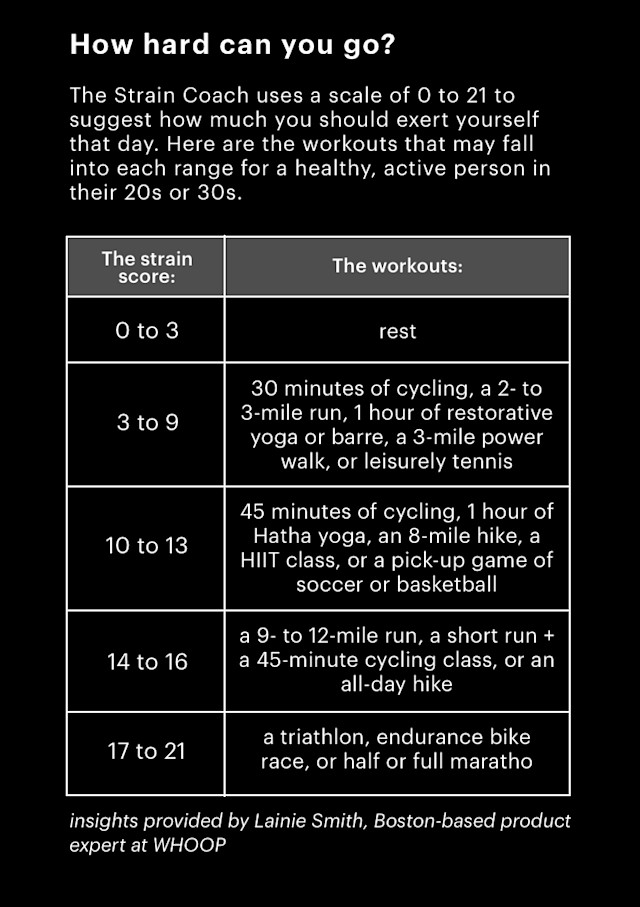The wearable's HRV data provides detailed fitness insights.
In Tech trainers love, Furthermore highlights the latest health and fitness devices that Equinox experts can't live without.
The tech: WHOOP Strap 3.0
Why trainers love it: The wearable is unique because of its focus on recovery, which it measures using heart rate variability (HRV) data.
"HRV refers to the slight differences in time between each of your heartbeats," says Ranah Farkhondeh, Tier X coach at E Madison Avenue in New York City. “These variations reflect your state of readiness and recovery.”
HRV regulates things like blood pressure, breathing rate, heart rate, digestion, and more. The higher yours is, the more efficiently your body is working and the more prepared you are to train hard. It goes up when you're sleeping well and managing stress, and down when you're training too hard or drinking too much alcohol, for instance.
The Strain Coach and Sleep Coach are two of the most unique features in the WHOOP app. The first suggests how intensely you can train that day, and the second suggests the ideal bedtime, wake-up time, and total amount of sleep you should get that night for optimal recovery. “The feedback paints a more vivid picture of what’s going on physiologically,” says Farkhondeh.
That said, the WHOOP Strap does have some pitfalls. "I wish it allowed you to add specific notes to help you draw more distinct correlations between certain habits and behaviors and the following day's recovery score," she notes. For example, you can mark whether you’ve consumed two or more alcoholic drinks within two hours of bed, but Farkhondeh would like to understand the effects of having a single drink, within that timeframe or earlier in the day.
She’d also love insights to her HRV (which is currently measured during sleep) at different points in the day, like after a workout and before bed. These updates would give athletes even greater insight into—and thus control over—their physiology.
Still, there are many lessons to be gleaned from the wearable's data. Here, Farkhondeh and two other Equinox experts identify six factors that hurt their HRV, and the fixes for each.

The lesson: Caffeine can mimic stress.
For a couple of months, Farkhondeh drank an extra cup of coffee every day. As a result, her resting heart rate (RHR) raised by five to 10 beats per minute, a significant difference that typically leads to a lower HRV.
The fix: Once she cut back to one daily cup, her RHR returned to baseline. If you do find yourself over-caffeinating, you can mitigate the effects with bananas, water, and more.
The lesson: Keto diets limit recovery.
Curious about the low-carb trend, Brianne Munch, Tier X coach at Greenwich in Connecticut, gave it a try. “On days when I had swapped carbs for healthy fats, I had lower recovery scores,” she says. The dietary change left her fatigued in and out of the gym.
The fix: Munch’s recovery scores jumped after she traded high-fat snacks like nuts and avocado for high-carb options like sweet potatoes. (Ideally, you’d get at least 40 percent of your calories from carbs.)
The lesson: Drinking alcohol should be a mindful activity.
After having one or two drinks with friends, Farkhondeh's HRV would drop by as many as 40 points.
The fix: Three changes have lessened the effect: She sips slowly, alternates alcohol with water, and stops drinking at least two hours before bed.
The lesson: Nervous excitement equals strain.
Until he started wearing a WHOOP strap, Patrick Hageman, Tier X coach at The Loop in Chicago, didn’t realize how much his emotional state impacted his body. “I was at a bodybuilding competition to watch one of my clients, and I was so anxious for her when she was on stage that my strap thought I was working out,” he says.
The fix: Now, Hageman practices self-care for a few minutes whenever stress is impacting his stats. Try meditation, relaxing breath work, and a DIY hand massage.
The lesson: A 33 percent recovery score calls for rest.
“We tend to have the mentality of ‘I need to get a workout in,’” Munch says. She used to power through tough sessions any time they were planned, even if she didn’t feel up for it.
The fix: When her WHOOP displays a recovery score (based on sleep and heart rate data) at or below 33 percent, she takes a day off. “My recovery has been so consistently low that I took four consecutive rest days.” She logs a moderate workout once her score falls between 33 and 66 percent and intense sessions when it’s higher.
Since making this change, she's noticed her body feels markedly more prepared for her workouts—and the extra rest days haven't led to a drop in fitness.
The lesson: Bedroom temperature affects body temperature.
At the start of winter, Farkhondeh’s HRV was significantly below average three days in a row. “I couldn’t identify any variables in my training or diet that could account for it,” she remembers. Then she realized that her heat had turned on. This forced her body to work harder than normal to control its temp overnight, messing with her recovery.
The fix: After turning on her air conditioning and fan for one night, her HRV returned to normal. Now, she keeps her bedroom at 68 degrees, which many experts say is best for sleep.
